Understand Everything About Anesthesia Machines: (And How To Buy It)
Contents
- 1 Introduction to Anesthesia Machines
- 2 Types of Anesthesia Machines
- 3 Components of Anesthesia Machines
- 4 Safety Features and Regulations for Anesthesia Machines
- 5 Anesthesia Machine Operation
- 6 Anesthesia Gas Delivery
- 7 Vaporizers in Anesthesia
- 8 Patient Monitoring in Anesthesia
- 9 Troubleshooting and Maintenance of Anesthesia Machines
- 10 Infection Control in Anesthesia Practice
Introduction to Anesthesia Machines
Click to learn how to buy anesthesia machines
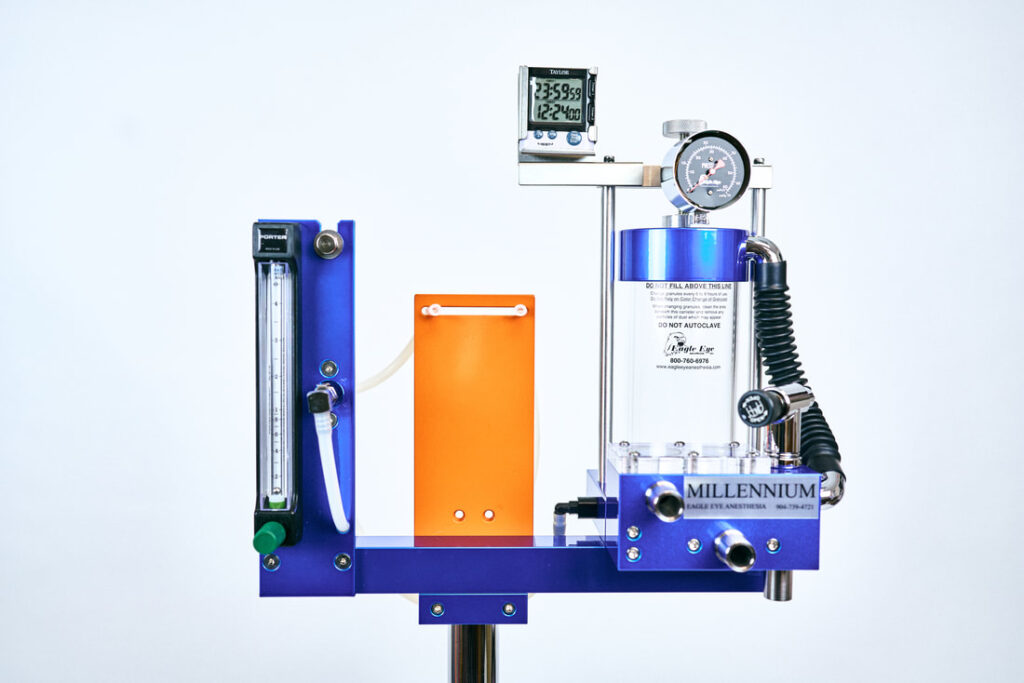
This introductory topic provides an overview of anesthesia machines and their significance in medical procedures. It sets the foundation for understanding the role of anesthesia machines in delivering anesthesia to patients during surgery and other medical interventions. In this tutorial, you’ll learn about the basic functions and components of anesthesia machines, as well as their critical role in patient care and safety. You will also learn how to purchase them.
Types of Anesthesia Machines
This topic delves into the various types of anesthesia machines used in medical settings. It provides an in-depth exploration of the different categories and models of anesthesia machines, including inhalation and intravenous anesthesia systems. Learners will gain a comprehensive understanding of the distinctions between these types and their respective applications, allowing them to make informed choices when selecting the appropriate anesthesia machine for specific medical procedures.
There are several types of anesthesia machines used in medical settings, each with its own set of features and applications. Here are some common types of anesthesia machines:
- Continuous Flow Anesthesia Machines:
- Also known as traditional anesthesia machines, these deliver a continuous flow of gas to the patient.
- They are commonly used in general anesthesia procedures and provide a constant supply of gas mixtures to the patient.
- Drawover Anesthesia Machines:
- These machines are compact and portable, making them suitable for field-based or remote medical procedures.
- They do not require a power source and rely on the user manually controlling the flow of gases through a breathing circuit.
- Balanced Anesthesia Machines:
- Balanced anesthesia is an approach that involves carefully adjusting the concentrations of different gases to achieve a desired anesthetic effect.
- Balanced anesthesia machines allow for precise control of multiple gas inputs and vaporizers to achieve the desired anesthetic depth.
- Anesthesia Workstations:
- Anesthesia workstations are advanced systems that integrate multiple components into a single unit.
- They typically include vaporizers, ventilators, monitoring devices, and advanced safety features in a compact design.
- Pediatric Anesthesia Machines:
- These machines are specifically designed for use with pediatric patients.
- They feature smaller components and adjustments to cater to the unique needs of children.
- MRI-Compatible Anesthesia Machines:
- MRI-compatible anesthesia machines are designed to operate safely within the magnetic field of magnetic resonance imaging (MRI) machines.
- They use non-magnetic materials and do not interfere with the MRI process.
- Anesthesia Machines with Closed-Loop Control:
- These machines use sophisticated algorithms and sensors to automatically adjust the flow of anesthetic gases and maintain a stable level of anesthesia.
- Closed-loop systems aim to reduce human error and improve patient safety.
- Transportable Anesthesia Machines:
- Designed for use during patient transportation within a healthcare facility, such as from the operating room to the recovery room.
- These machines are compact, lightweight, and have features that ensure patient safety during transit.
- Low-Flow and Minimal-Flow Anesthesia Machines:
- Low-flow and minimal-flow anesthesia machines are designed to minimize the consumption of anesthetic gases.
- They use re-breathing systems and advanced vaporizer technologies to reduce waste and environmental impact.
- High-Frequency Jet Ventilators (HFJV):
- HFJV machines deliver very high-frequency, low-tidal-volume ventilation to maintain oxygenation during certain surgical procedures, particularly in head and neck surgery.
These are some of the main types of anesthesia machines used in clinical practice. The choice of anesthesia machine depends on the specific requirements of the medical procedure, patient characteristics, and the preferences of the healthcare provider.
Components of Anesthesia Machines
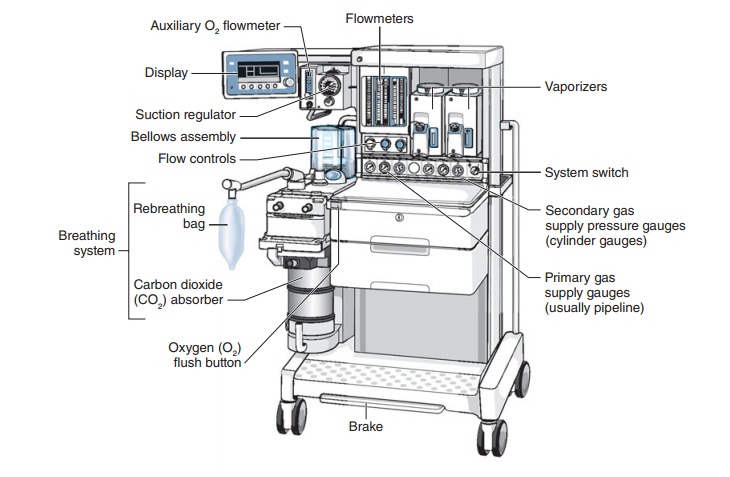
This tutorial topic focuses on the essential components that make up anesthesia machines. It offers a detailed breakdown of the key elements, such as gas sources, breathing circuits, vaporizers, and monitoring devices. Understanding the roles and functions of each component is crucial for healthcare professionals and technicians who operate, maintain, or troubleshoot anesthesia machines. This knowledge is fundamental for ensuring safe and effective anesthesia delivery in medical procedures.
The components of anesthesia machines may vary depending on the specific model and features, but here are some common components typically found in anesthesia machines:
- Gas Sources:
- Oxygen (O2): A primary gas used for breathing and supporting anesthesia delivery.
- Nitrous Oxide (N2O): Often used as an adjunct gas for general anesthesia.
- Compressed Air: Used for driving various components within the machine.
- Flow Control Valves:
- Flowmeters: Devices that control and measure the flow rates of gases accurately.
- Rotameters: A type of flowmeter with a tapered tube and a floating ball or float to indicate gas flow.
- Vaporizers:
- Anesthetic vaporizers: These devices vaporize liquid anesthetic agents and mix them with carrier gases, ensuring precise gas concentration for inhalation anesthesia.
- Breathing Circuits:
- Inspiratory and expiratory limbs: The pathways that connect the patient to the anesthesia machine, allowing the flow of gases.
- Y-piece: A component where the inspiratory and expiratory limbs meet, often equipped with a unidirectional valve to control gas flow.
- Breathing System:
- Breathing bags: Used to temporarily store gases and facilitate manual ventilation.
- Breathing hoses and connectors: Flexible tubing that transports gases between components.
- Carbon dioxide absorber: Removes exhaled carbon dioxide from the breathing circuit.
- Ventilator:
- Mechanical ventilator: Automated device that delivers controlled ventilation to the patient during anesthesia.
- Bag-valve-mask (BVM) apparatus: Manual ventilation tool operated by healthcare providers.
- Monitors and Sensors:
- Pulse oximeter: Measures oxygen saturation in the patient’s blood.
- Capnograph: Monitors end-tidal carbon dioxide (EtCO2) levels.
- Pressure sensors: Ensure proper pressure in the breathing circuit.
- Pressure-relief valves: Prevent excessive pressure buildup in the circuit.
- Oxygen analyzer: Measures the concentration of oxygen in the breathing circuit.
- Alarms and Safety Features:
- High and low oxygen concentration alarms.
- High and low airway pressure alarms.
- Apnea alarms.
- Gas supply failure alarms.
- Oxygen flush valve: Delivers 100% oxygen to the patient in emergencies.
- Waste Gas Scavenging System:
- Collects and disposes of excess anesthetic gases and prevents their release into the environment.
- Mounting and Support Structure:
- The framework that holds and supports various components of the anesthesia machine.
These components work together to provide a controlled and safe delivery of anesthesia to patients while ensuring proper monitoring and safety. It’s important to note that different anesthesia machines may have additional features and components depending on their design and intended use.
Safety Features and Regulations for Anesthesia Machines
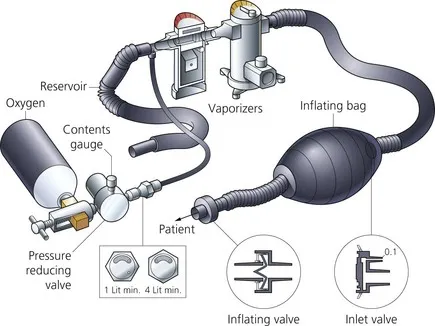
This topic delves into the safety features and regulatory standards that govern the use of anesthesia machines in healthcare settings. It covers the importance of adhering to safety guidelines and the role of built-in safety mechanisms in anesthesia machines to protect patients and healthcare providers. Additionally, it provides an overview of the various national and international regulations and standards that anesthesia machines must comply with to ensure their safe and effective use in medical procedures.
Safety features and regulations for anesthesia machines are critical aspects of ensuring the safe and effective delivery of anesthesia in medical procedures. Here are some common safety features and regulations associated with anesthesia machines:
Safety Features:
- Oxygen Failure Protection: Anesthesia machines are equipped with mechanisms that detect a loss of oxygen supply. When an oxygen failure is detected, these systems can trigger alarms and switch to a backup oxygen source to prevent interruptions in gas delivery.
- Gas Scavenging: Anesthesia machines feature waste gas scavenging systems that capture excess anesthetic gases to protect healthcare providers and patients from exposure to these gases, which can be harmful.
- Pressure Relief Valves: These valves prevent excessive pressure buildup in the breathing circuit, protecting the patient’s airway and lungs from barotrauma.
- Low Oxygen Alarms: Anesthesia machines are equipped with alarms that activate when the oxygen concentration falls below safe levels, ensuring that the patient receives an adequate oxygen supply.
- Positive Pressure Relief Valves: These valves release excess pressure in the breathing circuit to prevent overinflation of the patient’s lungs.
- Vaporizer Interlock Systems: Anesthesia machines often feature interlock systems that prevent the simultaneous use of multiple vaporizers to avoid the administration of an incorrect anesthetic agent.
- Emergency Oxygen Flush: An emergency oxygen flush valve allows healthcare providers to deliver 100% oxygen to the patient quickly in emergency situations.
- Pressure Monitoring: Pressure sensors and monitors in the breathing circuit help prevent excessive pressure and barotrauma.
- Inspiratory and Expiratory Gas Analysis: Anesthesia machines typically monitor and analyze the concentration of inhaled and exhaled gases to ensure the patient receives the correct gas mixture.
- Leak and Occlusion Detection: These features detect leaks or blockages in the breathing circuit and alert healthcare providers.
Regulations and Standards:
- ISO Standards: The International Organization for Standardization (ISO) has established standards for medical devices, including anesthesia machines. ISO 80601-2-13, in particular, pertains to the basic safety and essential performance of anesthesia machines.
- FDA Regulations: In the United States, the Food and Drug Administration (FDA) regulates the design, manufacturing, and labeling of medical devices, including anesthesia machines. Compliance with FDA regulations is crucial for market approval.
- CE Marking: In Europe, anesthesia machines must meet the requirements for CE marking, indicating compliance with European Union directives and standards.
- National Regulations: Many countries have their own national regulations and standards for medical devices, including anesthesia machines. These regulations may vary from one country to another.
- Safety Checklists: Healthcare facilities often use safety checklists and protocols to ensure that anesthesia machines are properly maintained and inspected regularly to meet safety standards.
- Manufacturer Guidelines: Anesthesia machine users must follow the manufacturer’s guidelines for operation, maintenance, and troubleshooting to ensure safety and compliance.
- Anesthesia Gas Standardization: Standards and guidelines exist for the labeling and color-coding of anesthesia gases and their connections to reduce the risk of errors.
Adhering to safety features and complying with regulations and standards is crucial for minimizing the risks associated with anesthesia delivery and ensuring patient and healthcare provider safety during medical procedures.
Anesthesia Machine Operation
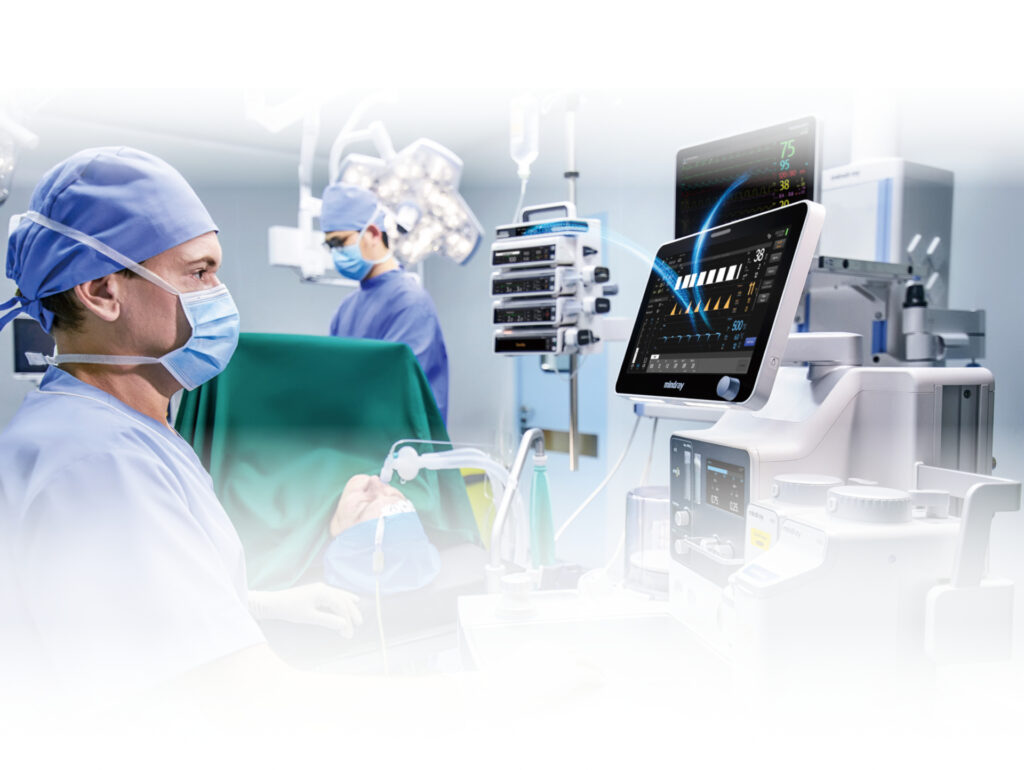
This topic provides a step-by-step guide on operating anesthesia machines. It covers the setup process, calibration, and essential safety checks to ensure the proper functioning of the machine. Understanding how to operate anesthesia machines is fundamental for healthcare professionals to deliver anesthesia safely and effectively during medical procedures while monitoring and maintaining patient well-being.
Operating an anesthesia machine involves a series of steps to ensure the safe and effective delivery of anesthesia during medical procedures. Here are the key aspects of anesthesia machine operation:
- Pre-Operational Checks:
- Verify the machine’s power source and ensure it is connected and functioning.
- Confirm the availability of an adequate oxygen supply.
- Check that the machine is on a stable surface and well-positioned for easy access.
- Ensure all components and accessories, such as breathing circuits and monitors, are present and in good condition.
- Machine Start-up:
- Power on the anesthesia machine following the manufacturer’s guidelines.
- Allow the machine to run through its self-check and initialization process, if applicable.
- Oxygen Supply:
- Confirm that the oxygen supply is available and that the oxygen cylinder or pipeline pressure is within the recommended range.
- Open the oxygen cylinder or ensure the oxygen pipeline is connected and functioning correctly.
- Gas Flow Settings:
- Adjust the gas flow rates, typically for oxygen and air, to the prescribed levels as per the patient’s requirements.
- Ensure that the flowmeters and rotameters are calibrated and provide accurate readings.
- Vaporizer Setup:
- Select the appropriate anesthetic agent and attach the vaporizer to the machine.
- Ensure that the vaporizer is filled with the correct anesthetic liquid and that it is properly seated and functioning.
- Breathing Circuit and Patient Connection:
- Assemble and connect the breathing circuit to the machine, ensuring a secure and airtight fit.
- Attach the patient’s endotracheal tube, face mask, or other airway device to the breathing circuit.
- Perform leak tests to check for any air or gas leaks in the circuit connections.
- Ventilator Settings:
- Configure the ventilator settings based on the patient’s characteristics and the surgical procedure, including tidal volume, respiratory rate, and inspiratory-to-expiratory ratio.
- Ensure that the ventilator is functioning correctly and that the patient is being adequately ventilated.
- Patient Monitoring:
- Connect and activate patient monitors, including ECG, pulse oximetry, capnography, and blood pressure monitoring devices.
- Confirm that all monitor readings are within the normal range and that alarms are set appropriately.
- Anesthesia Induction:
- Administer the anesthetic agent to induce anesthesia, monitoring the patient’s vital signs closely during the induction phase.
- Maintenance and Monitoring:
- Continuously monitor the patient’s vital signs and adjust anesthesia parameters as needed to maintain the desired level of anesthesia.
- Be prepared to manage any changes in patient condition or anesthesia depth.
- Emergencies:
- Know the location and operation of emergency features, such as the oxygen flush valve and manual ventilation equipment, in case of emergencies.
- Shutdown and Disconnection:
- After the procedure, gradually reduce the flow of anesthetic gases and allow the patient to recover.
- Disconnect the patient from the machine, properly dispose of any single-use components, and perform necessary cleaning and maintenance procedures.
Proper training and adherence to manufacturer guidelines are crucial for safe and effective anesthesia machine operation. Healthcare professionals responsible for operating anesthesia machines should be well-versed in these procedures to ensure patient safety and the success of medical procedures.
Anesthesia Gas Delivery
Description: This topic focuses on the delivery of anesthesia gases to patients using anesthesia machines. It covers the various gases used in anesthesia, the control of gas flow rates, and the monitoring of gas concentrations. Understanding anesthesia gas delivery is essential for healthcare professionals to administer anesthesia safely and precisely, ensuring patient comfort and well-being during surgical procedures.
Vaporizers in Anesthesia
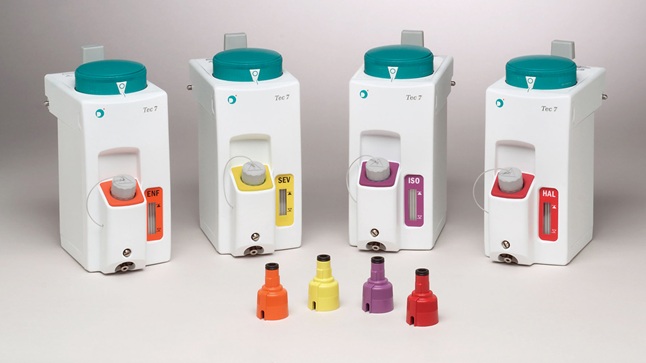
This topic explores the vital role of vaporizers in anesthesia machines. It covers the principles of vaporization, types of anesthetic agents used, and how vaporizers precisely control the delivery of anesthetic gases. Understanding vaporizers is crucial for healthcare professionals to ensure accurate and safe administration of volatile anesthetics during medical procedures, preventing overdose or under dose situations.
Vaporizers in anesthesia machines play a crucial role in administering volatile anesthetic agents to patients. These devices allow for precise control over the concentration of anesthetic vapor delivered to the patient. Here’s how vaporizers work:
- Volatile Anesthetic Agents: In anesthesia, volatile anesthetic agents are often used to induce and maintain general anesthesia. These agents are typically in liquid form at room temperature and pressure, and they vaporize easily. Common examples include sevoflurane, isoflurane, and desflurane.
- Vaporization Process: Vaporizers convert liquid anesthetic agents into a vapor that can be inhaled by the patient. This vaporization process is critical for maintaining a consistent and controlled level of anesthesia throughout a surgical procedure.
- Variable Bypass and Flow Control: Vaporizers typically have a variable bypass mechanism that diverts a controlled portion of the carrier gas (usually oxygen and air) around the liquid anesthetic. This bypassed gas is then saturated with the vapor of the liquid anesthetic.
- Concentration Dial: Vaporizers are equipped with a concentration dial or control knob that allows the anesthetist or healthcare provider to adjust the desired concentration of the anesthetic agent in the carrier gas. This dial is often calibrated in volume percent (e.g., 1-5%).
- Precision Mechanisms: Vaporizers are designed with precision mechanisms to ensure that the selected concentration remains stable and is not affected by changes in temperature, pressure, or gas flow rates.
- Temperature and Pressure Compensation: Vaporizers incorporate temperature and pressure compensation mechanisms to maintain the vaporization process at a consistent rate. This compensation ensures that the concentration of the anesthetic agent remains accurate, regardless of variations in environmental conditions.
- Specific Vaporizers for Specific Agents: Different volatile anesthetic agents have varying characteristics and vapor pressures. Therefore, vaporizers are often designed for use with specific agents to optimize performance and safety.
- One-Pass or Two-Pass Systems: Vaporizers can be categorized as one-pass or two-pass systems. One-pass vaporizers deliver the vaporized anesthetic directly to the patient’s breathing circuit. In contrast, two-pass systems recirculate the gas, allowing it to pass through the vaporizing chamber multiple times to achieve the desired concentration.
- Safety Features: Modern vaporizers are equipped with safety features to prevent the delivery of excessive concentrations of anesthetic gas. These features may include interlock systems that limit the use of multiple vaporizers simultaneously and ensure that only one vaporizer is in use at a time.
- User Interface and Monitoring: Vaporizers often have clear and user-friendly interfaces, allowing healthcare providers to set and monitor the selected concentration of the anesthetic agent. Some vaporizers also have alarms to alert providers to issues like low agent levels.
In summary, vaporizers in anesthesia machines work by controlling the concentration of volatile anesthetic agents in the carrier gas to ensure precise and safe delivery to the patient. They incorporate sophisticated mechanisms to maintain accuracy, compensate for environmental variables, and provide user-friendly interfaces for healthcare professionals to control and monitor anesthesia levels during surgery.
Patient Monitoring in Anesthesia
This topic covers the various monitoring devices and techniques used during anesthesia to ensure patient safety and well-being. It includes an in-depth exploration of patient monitoring equipment such as ECG (Electrocardiography), pulse oximetry, capnography, and blood pressure measurement. Understanding the principles and utilization of these monitoring tools is essential for anesthesia providers to respond effectively to changes in a patient’s condition and maintain optimal anesthesia depth.
Troubleshooting and Maintenance of Anesthesia Machines
This topic provides guidance on identifying and addressing common issues that may arise during the operation of anesthesia machines. It covers routine maintenance tasks to ensure the machine’s proper functioning and safety. Understanding how to troubleshoot and maintain anesthesia machines is crucial for healthcare professionals and technicians to prevent operational disruptions and deliver reliable anesthesia care in medical procedures.
Infection Control in Anesthesia Practice
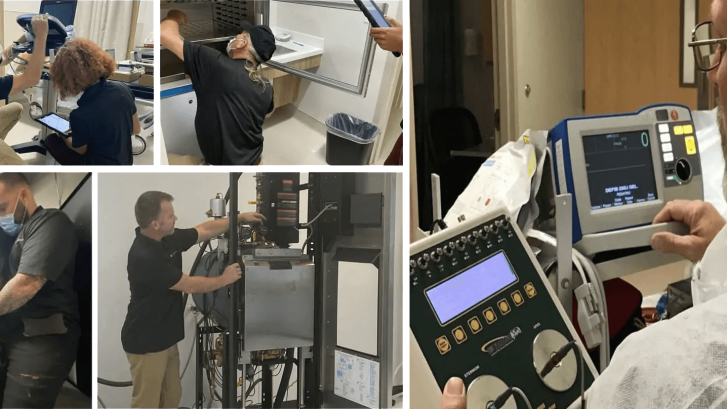
Infection control in anesthesia practice is essential to prevent the transmission of infections between patients and healthcare providers. The specific procedures may vary by healthcare facility and can be influenced by local guidelines and regulations. However, here’s a general overview of the infection control procedures in anesthesia practice:
- Hand Hygiene:
- Anesthesia providers should perform hand hygiene using soap and water or an alcohol-based hand sanitizer before and after every patient contact.
- Personal Protective Equipment (PPE):
- Healthcare providers should wear appropriate PPE, including gloves, gowns, masks, and eye protection when handling anesthesia equipment and patients.
- Cleaning and Disinfection:
- Anesthesia machines and equipment should be cleaned and disinfected according to established protocols and manufacturer guidelines. This includes the machine’s surfaces, knobs, and connectors.
- High-level disinfection or sterilization may be required for certain reusable items, such as laryngoscope blades and endotracheal tubes.
- Single-Use Items:
- Whenever possible, single-use items should be used to prevent cross-contamination.
- Dispose of single-use items properly in designated containers after each use.
- Environmental Cleaning:
- Anesthesia areas and operating rooms should be regularly cleaned and disinfected. Frequently touched surfaces should receive extra attention.
- Air Quality:
- Ensure that the operating room or anesthesia area has proper ventilation to reduce the risk of airborne contaminants.
- Maintain air filtration systems to prevent the spread of microorganisms.
- Aseptic Techniques:
- Use aseptic techniques during invasive procedures, such as the placement of intravascular catheters or endotracheal tubes.
- Sterile drapes and covers should be used to maintain a sterile field.
- Waste Disposal:
- Dispose of medical waste, including contaminated materials and sharps, in accordance with regulations and guidelines.
- Patient Preparation:
- Prepare the patient for anesthesia in a clean and sterile manner, including the site where catheters or tubes will be inserted.
- Staff Training and Education:
- Healthcare providers involved in anesthesia should receive proper training on infection control protocols and best practices.
- Regular education and updates on infection control procedures are crucial.
- Surveillance and Reporting:
- Healthcare facilities should have a system in place for monitoring and reporting healthcare-associated infections (HAIs) related to anesthesia practice.
- Timely reporting of infections or potential infection control breaches is important for managing and preventing outbreaks.
- Compliance with Guidelines and Regulations:
- Follow national and local guidelines and regulations related to infection control in anesthesia practice. This includes compliance with the Occupational Safety and Health Administration (OSHA) standards and guidelines from healthcare authorities.
- Equipment Maintenance:
- Ensure that anesthesia equipment, including breathing circuits and vaporizers, is properly maintained and cleaned to prevent contamination.
- Post-Procedure Clean-Up:
- After the procedure, thoroughly clean and disinfect all equipment and surfaces used during the anesthesia.
Infection control in anesthesia practice is a comprehensive process that involves strict adherence to protocols, thorough cleaning and disinfection, and maintaining aseptic conditions to protect both patients and healthcare providers from infections. Healthcare facilities should have infection control teams or experts responsible for implementing and monitoring these procedures.

